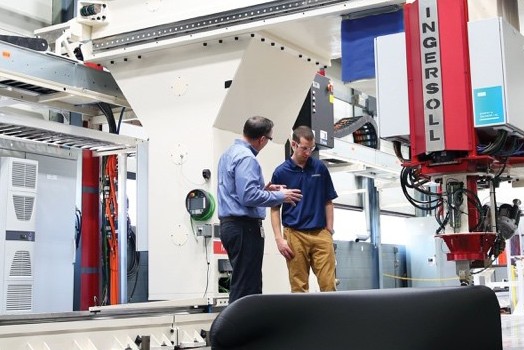Imagine an industrial 3D printer that can also perform milling, fiber placement, tape laying, inspection, and trimming…This is the all-in-one machine that Ingersoll Machine Tools, a global supplier of additive and subtractive machine tools, develops.
Named MasterPrint™, this large machine can print with thermoplastics and machine parts to their final shape within the same platform. It is designed to make tools for the aerospace, space, and marine industries.
“At one minute the machine could be adding material, the next subtracting it with the milling head,” says Jason Melcher, Vice President Sales at Ingersoll. All the while, the machine maintains highly precise tolerances.
Here is the thing, complex machining applications require a combination of hardware and software that can meet manufacturing costs without sacrificing quality. To handle this issue, Ingersoll chose the modular, scalable and open Sinumerik 840D sl CNC system from Siemens for its portfolio.
“We have found a CNC hardware and software partner in Siemens who is willing to develop and encompass advanced capabilities into their products and to enable us to achieve our strategic goals and serve the needs of our customers by shortening their time-to-market and increasing their profitability”, Piergiorgio Assandri, Business Director, Ingersoll Machine Tools.
For those who are not familiar with Sinumerik 840D sl, the system is the control platform for Ingersoll’s entry-level robotic platforms MasterPrint Robotic™ and MasterPrint Continuous Filament™ – as well as for its gigantic industrial 3D printer MasterPrint™, the machine that prints with thermoplastics. Manufacturing costs can be reduced by 75 percent and lead times shortened from months to days.
Siemens explains that the Siemens Virtual NC Kernel (VNCK) is a pivotal aspect in the modus operandi of this platform. Ingersoll uses it to embed the real CNC kernel into a virtual machine, allowing it to completely emulate real machine tool control and directly import the commissioning archive of the actual machine. Doing saves time through faster commissioning and helps Ingersoll get the machine to its customers faster. End-customers benefit too with the ability to simulate the manufacturing of their product and shorten their time-to-market while increasing production quality.
“Our customers value our capability to create a digital twin in the design phase, because it gives them reassurance in terms of feasibility and the ROI targets they have set for themselves,” explains Jason Melcher.
Remember, you can post free of charge job opportunities in the AM Industry on 3D ADEPT Media or look for a job via our job board. Make sure to follow us on our social networks and subscribe to our weekly newsletter : Facebook, Twitter, LinkedIn & Instagram ! If you want to be featured in the next issue of our digital magazine or if you hear a story that needs to be heard, make sure to send it to contact@3dadept.com






